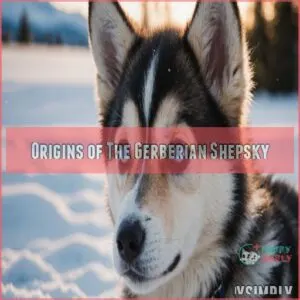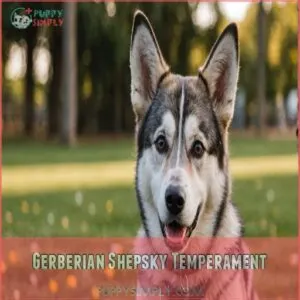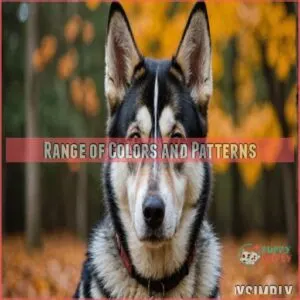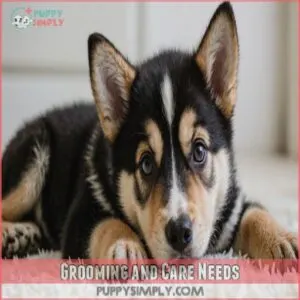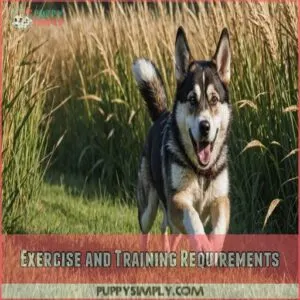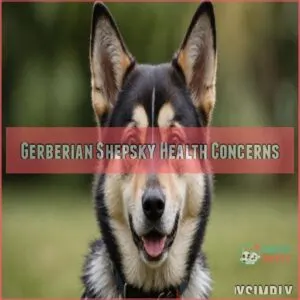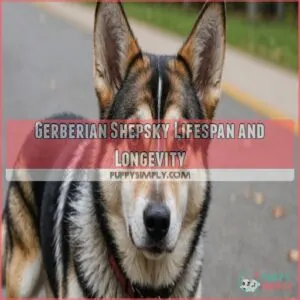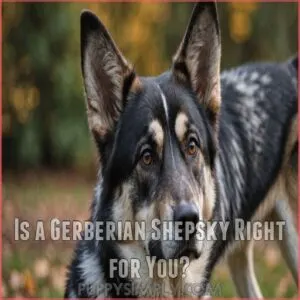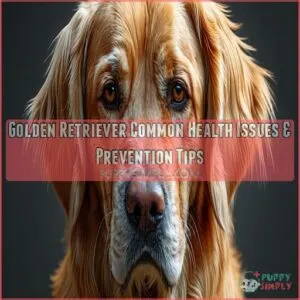This site is supported by our readers. We may earn a commission, at no cost to you, if you purchase through links.
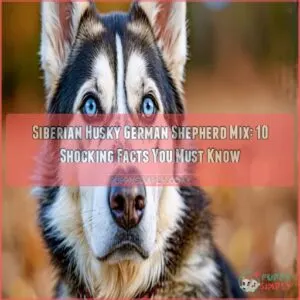 You’re curious about a Siberian Husky German Shepherd mix? That’s awesome! These dogs, also called Gerberian Shepskies, are a whirlwind of energy and loyalty.
You’re curious about a Siberian Husky German Shepherd mix? That’s awesome! These dogs, also called Gerberian Shepskies, are a whirlwind of energy and loyalty.
Imagine the intelligence of a German Shepherd, known for their high working intelligence and trainability, combined with the playful spirit of a Husky – it’s a recipe for an amazing companion, but it’s not all puppy kisses and rainbows.
They need lots of exercise and training. Don’t underestimate their need for mental stimulation!
Are you ready for a dog that’ll challenge you, love you fiercely, and maybe even steal your socks?
We’ll explore their unique needs and quirks in more detail, so you can be fully prepared for this incredible breed.
Table Of Contents
- Key Takeaways
- Origins of The Gerberian Shepsky
- Gerberian Shepsky Temperament
- Gerberian Shepsky Physical Characteristics
- Grooming and Care Needs
- Exercise and Training Requirements
- Gerberian Shepsky Health Concerns
- Diet and Nutrition for Gerberian Shepskys
- Gerberian Shepsky Lifespan and Longevity
- Is a Gerberian Shepsky Right for You?
- Finding a Reliable Gerberian Shepsky Breeder
- Frequently Asked Questions (FAQs)
- What is a Siberian Husky German shepherd mix?
- Is a German Shepherd Husky a good mix dog?
- What is a German Shepherd husky mix made of?
- How big is a German Shepherd husky mix?
- Are Siberian Husky & German Shepherd the same dog?
- How to train a Siberian Husky German shepherd mix puppy?
- Is a German Shepherd Husky mix a good dog?
- What are the pros and cons of the Shepsky?
- How big will a husky German Shepherd mix get?
- Are shepsky high maintenance?
- How do Shepskies handle being alone at home?
- What are common behavioral issues in Shepskies?
- Are Shepskies good with kids and other pets?
- How much do Gerberian Shepskies shed annually?
- What is the typical Shepsky exercise routine?
- Conclusion
Key Takeaways
- You’ll have an energetic and intelligent companion in a Gerberian Shepsky, blending the loyalty of a German Shepherd with the playful spirit of a Husky.
- Exercise and mental stimulation are crucial; expect at least an hour of active play daily to keep them happy and prevent destructive behaviors.
- Grooming can be high maintenance due to their thick double coat, with regular brushing needed to manage shedding, especially during seasonal changes.
- Early socialization and consistent training are essential for managing their energetic nature and ensuring they fit well with families and other pets.
Origins of The Gerberian Shepsky
You’ve likely seen these striking dogs before, but did you know the Gerberian Shepsky’s story began in the 1990s?
This unique mix of Siberian Husky and German Shepherd emerged during the designer dog boom, quickly winning hearts with its unique blend of traits from two beloved breeds.
History of The Siberian Husky German Shepherd Mix
The Gerberian Shepsky’s origins are a tale of two worlds colliding.
You’re looking at a mix of the loyal German Shepherd and the adventurous Siberian Husky.
This hybrid breed emerged from the designer dog boom, blending the best traits of both parents.
Breeders aimed to create a dog with the Shepherd’s intelligence and the Husky’s endurance.
The result? A unique crossbreed that’s been turning heads since its inception.
Rise of The Gerberian Shepsky in The 1990s
In the 1990s, you’d have witnessed the Gerberian Shepsky’s meteoric rise.
This designer dog trend took off as breeders mixed Siberian Huskies with German Shepherds, creating a unique blend of strength and beauty.
The popularity spike raised questions about breeder ethics and health concerns.
Despite genetic diversity worries, the Shepsky breed captured hearts with its striking looks and dynamic temperament.
Would you have jumped on this trend?
Breeding Goals and Characteristics
Ever wondered why breeders mix German Shepherds, a breed known for its exceptional protectiveness and trainability, with Siberian Huskies, as the German Shepherd’s natural protective instincts can be channeled in a healthy way through at least an hour a day of vigorous exercise, which is especially important for rare black German Shepherds. Ever wondered why breeders mix German Shepherds and Siberian Huskies?
They’re aiming for a powerhouse pup with the best of both worlds.
Shepsky breeders focus on:
- Combining intelligence and loyalty
- Balancing energy levels for an active yet manageable dog that requires at least 30-60 minutes of exercise twice a day.
- Merging striking appearances for a unique look
- Enhancing adaptability to various climates
You’ll get a hybrid dog that’s smart, loyal, and eye-catching.
Just remember, temperament can be a wild card!
Gerberian Shepsky Temperament
You’ll find that a Gerberian Shepsky is a lively and affectionate companion, blending the loyalty of a German Shepherd with the friendliness of a Siberian Husky.
Their temperament can vary, but with the right training and socialization, they become well-mannered family members who keep you on your toes with their boundless energy!
Personality Traits and Energy Levels
Getting a grip on the Gerberian Shepsky’s personality can be a roller coaster! With Husky stubbornness and Shepsky intelligence, as both breeds require positive reinforcement training strategies such as clicker training methods, these dogs need ample energy outlets.
Regular socialization is a must to manage their dog energy level and dog temperament.
Be prepared for training challenges that test your patience but pay off with an amazingly loyal companion.
| Traits | Details | Tips |
|---|---|---|
| Intelligence | Highly intelligent | Use puzzles |
| Energy Level | Very high | Daily exercise |
| Temperament | Loyal and lively | Consistent rules |
German Shepherd and Siberian Husky Mix Character Traits
A Gerberian Shepsky can be a fascinating blend of personalities.
You’ll find their Shepsky temperament a mix of loyalty and playfulness, with protective instincts shining through.
Their energy can lead to training challenges, but also rewarding companionship.
With a high prey drive, they’re best suited for families ready to embrace their German Shepherd and Siberian Husky mix character traits!
Training and Socialization for a Balanced Temperament
Tackling the spirited nature of a Gerberian Shepsky calls for early socialization and consistent training.
Picture them as intelligent high-energy dogs with a flair for learning!
Use positive reinforcement to instill good behavior, and don’t shy away from handling aggression with patience.
Establish consistent commands for puppy training, ensuring they thrive in dog socialization, and enjoy balanced temperaments.
Gerberian Shepsky Physical Characteristics
When you meet a Gerberian Shepsky, you’re likely to be charmed by their striking blend of features from both parent breeds.
With their alluring eyes, often mismatched in color, and a coat ranging from a wolf-like gray to a striking sable, these loyal companions are as visually stunning as they’re unique.
Size and Weight Expectations
Curious about the size your Shepsky might become? These hefty furballs can reach impressive sizes! Here’s what to expect:
- Growth charts reveal they’re medium to large-sized.
- Adult size typically spans 23-27 inches tall.
- Weight range varies from 55 to 75 pounds.
- Puppy size shows significant weight variation.
Isn’t it fascinating how they grow?
Coat Type, Length, and Shedding
So, you’ve got a grasp on their size.
Now, let’s talk about their coat. Your Gerberian Shepsky will likely have a thick double coat, meaning lots of shedding, which is especially heavy during the seasonal shedding cycles.
Prepare for a furry friend who sheds year-round, especially during shedding season.
Invest in good grooming tools; regular brushing is your best friend. While not hypoallergenic, proper coat care minimizes shedding.
Remember, a happy dog is a well-groomed dog!
Range of Colors and Patterns
In a world of endless possibilities, the Gerberian Shepsky dazzles with its striking coat variations.
You’ll discover:
- Color Genetics play a key role, leading to dramatic hues like sable and blue.
- Pattern Influences create unique markings, making each Shepsky one-of-a-kind.
- Shedding Patterns shift seasonally, keeping things interesting (and your vacuum busy!).
These combinations make for truly mesmerizing dog features.
Grooming and Care Needs
Taking care of a Gerberian Shepsky’s grooming needs might seem challenging at first, but it’s all about routine and consistency.
With their thick double coat, regular brushing is essential to manage shedding and keep their coat shiny.
While occasional baths, nail trimming, and ear cleaning will keep them looking and feeling their best!
Shedding and Brushing Needs
Your Shepsky will definitely keep you busy during shedding season!
Their double coat means a regular grooming schedule is essential.
Use a good brush type and deshedding tools to keep their coat in top shape.
Consistent dog grooming can greatly reduce dog shedding, helping to maintain a clean home.
Who knew this mix of Siberian Husky and German Shepherd could be such a hair-raiser?
Bathing Frequency and Tips
A Shepsky’s shedding can keep you busy, but regarding baths, less is more.
As double-coated breeds like their Siberian Husky parent, they need less frequent washes but more grooming to prevent matting.
Double-coated breeds often follow a specific bathing schedule to maintain their coat health.
Once every three months is ideal, unless they’re mud wrestlers!
Opt for gentle dog shampoos to protect their skin.
Use lukewarm water and make sure thorough drying methods are used to prevent chills.
These German Shepherd and Siberian Husky mix grooming tips keep your pup clean and comfy!
Nail Care and Ear Cleaning
After bath time, don’t forget about nail care and ear cleaning for your German Shepherd Husky mix.
Regular nail trimming with the right tools, such as husky nail clippers, prevents discomfort, while cleaning those ears helps dodge pesky infections.
Professional grooming is handy, but home remedies work too.
Keep dog health in check, and everyone stays happy!
How often should you do these? Aim for weekly checks.
Exercise and Training Requirements
You’ll need plenty of energy to keep up with a Gerberian Shepsky, as this mix thrives on daily exercise and mental challenges!
From long walks to puzzle games, their exercise routine isn’t just a suggestion—it’s a necessity to keep them happy and well-behaved.
Daily Walks and Physical Activity
Keeping that gorgeous coat clean is one thing, but don’t forget your Shepsky’s energy!
Daily walks are a must; aim for at least an hour, broken up if needed.
Remember off-leash safety – a securely fenced area is ideal.
Think playtime, too! Fetch, tug-of-war – these are great for dog exercise.
Your Shepsky needs plenty of physical activity, so don’t underestimate their exercise needs! A tired dog is a happy dog, right?
Mental Stimulation and Training
Imagine your Gerberian Shepsky working their way through a maze of puzzle games and training challenges!
These intelligent dogs need mental stimulation just as much as physical exercise.
Regular enrichment activities will keep their minds sharp and prevent boredom, which can lead to unwanted dog aggression.
Embrace the power of mental agility, and watch your Siberian Husky-German Shepherd mix thrive!
Suitable Activities for Gerberian Shepskys
Once your Gerberian Shepsky has mastered basic training, it’s time to explore suitable activities that boost their health and happiness!
Channel their energy with these fun pursuits:
- Hiking: Explore new trails together.
- Agility: Engage their quick minds and nimble paws.
- Fetch or Frisbee: Perfect for their spirited nature.
These activities nurture both body and soul!
Gerberian Shepsky Health Concerns
When you’re considering a Gerberian Shepsky, understanding their health concerns is important since they’re prone to issues like hip and elbow dysplasia, as well as vision problems.
By paying attention to these potential health challenges, you can guarantee your furry friend’s long and healthy life—because who doesn’t want more time with their loyal companion?
Common Health Issues in Gerberian Shepskys
You’re in for a ride when exploring the health of your Gerberian Shepsky.
This hybrid can face challenges like allergies, eye problems, and digestive issues, similar to the common health issues found in Golden Retrievers.
Don’t forget about the power of genetic testing to uncover potential risks.
Although Shepsky prices may make you pause, investing in their canine health guarantees your furry companion leads a happier, healthier life!
common health issues in breeds
Hip and Elbow Dysplasia
After considering common health issues, you’ll want to keep an eye on hip and elbow dysplasia, particularly for Gerberian Shepskys.
Early detection through genetic testing can make all the difference.
Treatment options and prevention strategies, including lifestyle adjustments, are essential for managing these dog health concerns.
Remember, mixed breeds like your German Shepherd-Husky mix need attentive care to stay fit and happy!
Eye Problems and Vision Loss
Beyond managing hip and elbow issues, keep an eye on your Gerberian Shepsky’s eye health!
This mix may face eye conditions like juvenile cataracts or vision loss, impacting their life.
You can also consider purchasing Gerberian Shepsky eye drops online for your pet’s needs.
Prioritize regular vision tests and preventive care.
Wondering what steps to take? Check these out:
- Monitor for eye problems.
- Schedule routine vision tests.
- Consider treatments for detected conditions.
Diet and Nutrition for Gerberian Shepskys
Feeding your Gerberian Shepsky properly is essential for their health and happiness.
We’ll explore what nutrients they need, how much to feed them, and the best types of food to keep your furry friend thriving!
Nutritional Requirements for Gerberian Shepskys
Health concerns often prompt a focus on diet; for your Gerberian Shepsky, understanding nutritional needs is key to a happy life.
Think about puppy nutrition, adult diet, and senior care.
Avoid food sensitivities and dietary allergies by choosing quality dog food.
Balance their caloric intake with exercise, ensuring lean muscle mass and healthy weight.
Have you checked your pet’s diet today?
Choosing The Right Food for Your Gerberian Shepsky
When choosing food for your Gerberian Shepsky, consider their age and any food allergies.
A raw diet might suit some, but make sure it meets their dog nutrition needs.
Puppy food gives a solid start, while adult and senior food supports ongoing health.
Don’t forget about dog dental care, as crunchy kibble can help maintain those pearly whites!
Feeding Schedule and Portion Control
Selecting the right food sets the stage for healthy mealtimes. But what about portions? Getting it just right can be trickier than catching a runaway puppy! Here’s your guide:
- Puppy diet: Small meals, a few times daily.
- Adult feeding: Twice a day works well.
- Weight management: Monitor regularly.
- Food allergies: Be watchful.
- Homemade recipes: Consult your vet.
Gerberian Shepsky Lifespan and Longevity
When you’re talking about the lifespan of a Gerberian Shepsky, the average ranges from 10 to 14 years, which is fairly typical for medium to large breeds.
Gerberian Shepsky longevity can be influenced by several factors, like regular veterinary care, proper diet, and plenty of exercise.
After all, a happy dog is often a healthier one!
Average Lifespan of Gerberian Shepskys
A Gerberian Shepsky’s life isn’t measured in dog years, but in memories.
Expect your furry friend, a mix of German Shepherd and Siberian Husky, to live around 10 to 14 years.
With the right care, such as a healthy diet and regular exercise, they can enjoy a full, vibrant life.
They’ll keep you on your toes, that’s for sure!
Factors Affecting Gerberian Shepsky Lifespan
Understanding your Gerberian Shepsky’s lifespan involves more than just years.
A balanced life revolves around several factors.
Here’s what matters most:
- Genetics: This mix inherits traits from both German Shepherds and Siberian Huskies.
- Nutrition: Quality dog food fuels longevity.
- Exercise: Regular activity keeps them fit and healthy.
- Healthcare: Regular checkups catch issues like pannus early.
Is a Gerberian Shepsky Right for You?
So, you’re thinking about welcoming a Gerberian Shepsky into your life?
Let’s explore if this energetic, intelligent mix is the right fit for your home and lifestyle, considering their needs and your capabilities.
Pros and Cons of Owning a Gerberian Shepsky
Gerberian Shepskies combine the loyalty of German Shepherds with the adventurous spirit of Siberian Huskies.
They’ve a unique wolf-like appearance due to their mixed breed ancestry.
You’ll enjoy a smart, energetic companion with strong watchdog abilities.
However, they require significant Shepsky training, exercise, and grooming, which can be costly.
If you’re prepared for their high energy and potential dog barking, this blend might just be your ideal furry buddy!
Suitability for Families With Children
Balancing energy levels and family time? A Gerberian Shepsky could be your perfect match!
They’re generally good with kids but require child-friendly training and supervision to guarantee safety.
Their playful nature means endless fun, yet managing their enthusiasm is key.
Focus on socialization tips to foster affection and reliability in your spirited German Shepherd Husky mix.
Happy wagging awaits!
Compatibility With Other Pets and Living Situations
Thinking about your family’s Shepsky hanging with other pets?
They can be friends with other dogs, but you’ll need to supervise their time with cats.
Be cautious around small critters, as the German Shepherd Husky mix has a high prey drive.
Got a small apartment?
These energetic pups do best with space, making them better for homes with yards.
Finding a Reliable Gerberian Shepsky Breeder
Searching for a reliable Gerberian Shepsky breeder can seem overwhelming, but it’s important to make sure you’re getting a healthy, well-bred puppy.
Don’t rush the process—take your time, ask questions, and be wary of red flags!
Tips for Finding a Reputable Breeder
You’ve decided a Gerberian Shepsky is the right fit—now, finding a breeder requires care.
Prioritize those with strong breeder ethics and focus on these steps:
To aid your search, you can also explore online directories, such as those listing Gerberian Shepsky breeders trusted breeder networks.
Make sure each puppy has thorough health screenings.
- Check breeder reputation and ask for references.
- Observe puppy socialization practices and meet the parental lineage—both the German Shepherd and Siberian Husky.
Red Flags to Watch Out for in a Breeder
When hunting for a Gerberian Shepsky breeder, watch for red flags like puppy mill operations or lack of health guarantees.
Be wary of price gouging on these adorable German Shepherd-Siberian Husky mixes.
Ethical breeding practices, coupled with transparency about puppy care, are essential.
Would you trust someone who’s vague about their dogs’ health?
Consider this checklist:
| Warning Sign | Why It Matters | What to Do |
|---|---|---|
| No Health Tests | Risk of genetic issues | Ask for proof |
| Dodgy Contracts | Lack of health guarantees | Check details |
| High Prices | Possible price gouging | Compare breeders |
Frequently Asked Questions (FAQs)
What is a Siberian Husky German shepherd mix?
The apple doesn’t fall far from the tree!
A Siberian Husky German Shepherd mix, or Gerberian Shepsky, blends loyalty and friendliness.
They’re active, intelligent, and require lots of exercise, making them ideal for energetic families.
Is a German Shepherd Husky a good mix dog?
Bringing a German Shepherd Husky mix into your home offers both rewards and challenges.
These energetic dogs are loyal and intelligent, needing plenty of exercise and training.
Make sure you’re ready for their unique mix of traits and responsibilities.
What is a German Shepherd husky mix made of?
A Gerberian Shepsky blends brawn and brains by merging a Siberian Husky’s playful spirit with a German Shepherd’s loyalty.
You’ll enjoy a lively, intelligent companion that loves adventure and thrives with leadership, training, and space.
How big is a German Shepherd husky mix?
You’re curious about their size, huh?
A German Shepherd Husky mix stands about 23 to 27 inches tall and weighs between 55 to 75 pounds.
They’re like having a lively giant always by your side!
Are Siberian Husky & German Shepherd the same dog?
Imagine this: Siberian Huskies and German Shepherds are like night and day—both beloved but distinct!
Huskies charm with their endurance and fluff, while Shepherds impress with intelligence and loyalty.
They’re unique, making their mix fascinatingly unpredictable!
How to train a Siberian Husky German shepherd mix puppy?
Start early with consistent, positive training. Use treats and praise; they’re smart, but stubborn! Socialize them extensively, early exposure prevents future issues. Remember patience; it’s a marathon, not a sprint!
Is a German Shepherd Husky mix a good dog?
A German Shepherd Husky mix, or Gerberian Shepsky, makes a great pet if you’re ready for a loyal, active companion.
They need lots of exercise, training, and attention.
Their varying personalities require patience but reward you with loyalty.
What are the pros and cons of the Shepsky?
Shepskies are loyal, smart, and energetic, making them great companions for active families.
They demand substantial exercise and training.
Their stubbornness can be challenging.
Be ready for shedding and potential health issues like hip dysplasia.
How big will a husky German Shepherd mix get?
A husky German Shepherd mix usually grows to 23-27 inches tall and weighs 55-75 pounds.
They sport a double coat with various colors and markings, combining the husky’s and German Shepherd’s distinctive traits beautifully.
Are shepsky high maintenance?
Owning a Shepsky can be high maintenance!
They need lots of exercise, grooming, and mental stimulation to prevent boredom and destructive behavior.
Regular training sessions and socialization also help manage their energetic and independent nature.
How do Shepskies handle being alone at home?
Leaving a Shepsky alone can be tricky since they’re prone to separation anxiety.
They crave company and mental stimulation, so long absences might lead to boredom and mischief.
Scheduled exercise and toys can help ease their time alone.
What are common behavioral issues in Shepskies?
Think of training a tempest; Shepskies can be stubborn and independent, leading to excessive barking, aggression, and destructiveness if not properly socialized or exercised.
Consistent, firm training helps channel their energy into positive behaviors.
Are Shepskies good with kids and other pets?
Shepskies can be great with kids, but early socialization’s key! They’re usually okay with other dogs, but small animals? Not so much. Proper training is your best friend!
How much do Gerberian Shepskies shed annually?
You’d think getting a Gerberian Shepsky would mean owning just a dog, not a walking fur factory!
Expect year-round shedding with heavier blows during spring and fall.
Regular grooming is key to taming the fur storm.
What is the typical Shepsky exercise routine?
Your Shepsky craves daily exercise to burn off energy!
Aim for at least one hour of active play, like running or hiking, mixed with mental stimulation through games and training sessions.
Keep things lively and engaging!
Conclusion
Picture adopting a Gerberian Shepsky as starting on an adventurous journey, filled with lively trails and joyful surprises.
These dogs, the perfect blend of Siberian Husky and German Shepherd, offer an energetic mix of loyalty and playfulness.
They’ll keep you on your toes with their need for exercise and mental challenges.
If you’re ready for a furry companion who might just steal your socks and your heart, the Siberian Husky German Shepherd mix could be your perfect match!

